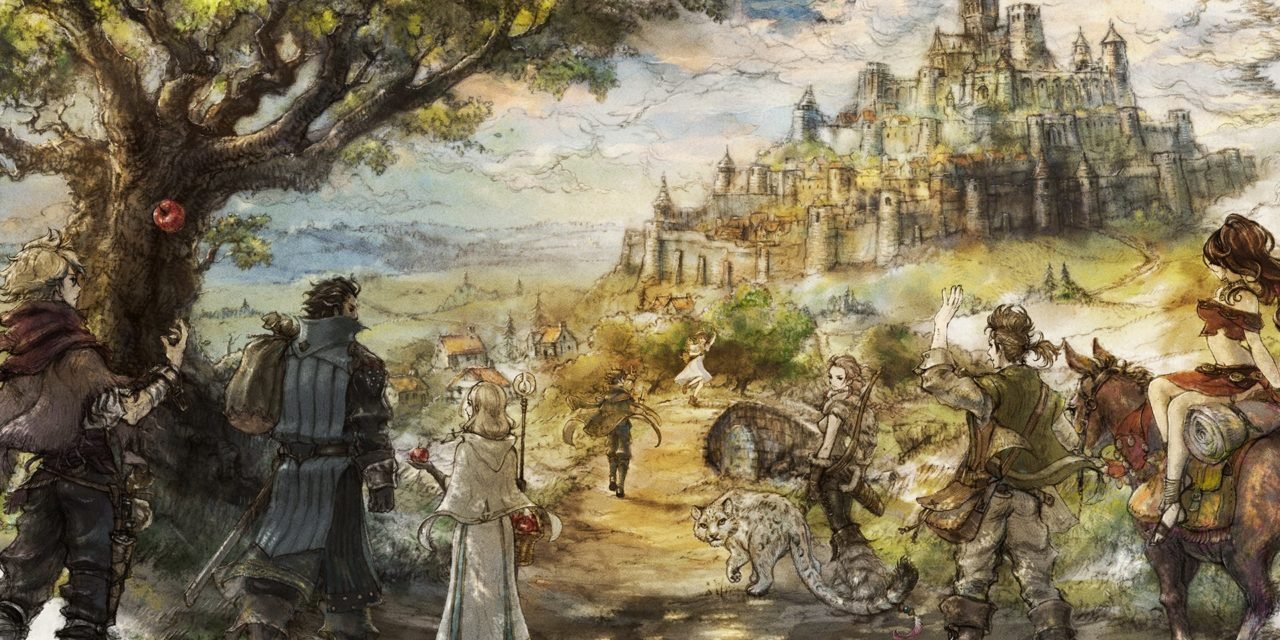Square Enix calling back to their roots with a modern twist
“Octopath Traveler? What’s that?”
Octopath Traveler is a game made by Square Enix, and was a way to call back to their roots with the likes of their most famous series: Final Fantasy. The game proved to be a massive success, receiving a lot of praise with its characters and artstyle. What makes it so enjoyable to play through? Lets find out.
The Story
When you start a new game, you begin by picking from one of eight playable characters. The characters are Olberic, Cyrus, Tressa, Ophelia, Primrose, Alfyn, Therion, and H’aanit. All of their stories are drastically different from one another. Alfyn, for instance, is an aspiring apothecary who chose his profession after being saved by a stranger when he was a child and had a fatal illness. Primrose, on the other hand, is a dancer who wants to exact revenge on the men who killed her father. And that’s just talking about 1/4 of the cast. No matter who you choose to start off as, however, you will end up gathering the other seven party members to join your team as you all travel around the game’s setting, a continent known as Orsterra.
The Gameplay
At its core, Octopath Traveler is an RPG, through and through. You’ll wander around the various locations that Orsterra has to offer, interact with the citizens in towns and cities, fight monsters, collect armor and weapons, etc. Now every single party member starts off with a singular class, and all of them play differently from each other. For example, Alfyn is an Apothecary, so he specializes in healing allies, making them immune to status effects, as well as his signature skill, Concoct, to make various kinds of effects to his allies or his enemies. H’aanit, on the other hand, is a Hunter, with her signature ability being able to capture monsters in the wild and summon them to assist her. All of the classes can only use specific weapons, however. For example, Alfyn is an Apothecary, meaning that he can only use Axes. While for Tressa, being a Merchant, can only use Bows and Spears. Throughout Orsterra, however, you can find various shrines that pay respects to the game’s gods. Should they find the shrines, they will be rewarded with being able to have that class be apart of their main class, along with their abilities and weapons.
The combat system is fun, too. The one who makes a move will be determined by whoever’s on the top right of the screen. Every enemy has some kind of weakness, but you’ll have to figure out what their weaknesses are, though. If you attack a monster’s weakness enough times, they’ll be entered into a Break status, where they won’t act for the next turn, and every attack that’s dealt to them will always be a critical hit. Another part of the battling system is the Boost system. During the fight, there’s a little meter signified by dots next to the character’s name. The dots, known as “Boost Points,” can be stored up to five times. By pressing the R button (for the Nintendo Switch), you can either make another attack on the enemy, boost stats even higher, or increase the potency of a certain attack. And you can boost up to three times, but you won’t be able to grab another Boost point for that specific character when it’s their turn again. This adds in another form of strategy, having the players think about when to use their Boost Points, and what abilities to go for.
The Characters
The game has many characters to interact with, but of course the main stars are the eight you play as. No two are alike, and that’s what I love about it. For instance, Tressa is an optimistic merchant who wants to see what the world has to offer due to being in her hometown for her entire life, while Cyrus is a prodigy who teaches the students of a city, but can be oblivious to people’s emotions. There’s also the characters that are either exclusive to the stories, or the ones that appear during sidequests. Some of them are essentially stories of their own, especially with a few having multiple sidequests to tackle. Plenty are likable, while others…not so much.
Though one of the problems I had with the game is that even though the game progresses through a character’s specific story, the other party members don’t really interact in the cutscenes. They do interact, sure, but that’s only after cutscenes. And that’s a shame, too, because I would’ve loved to see how the cast would respond in certain situations, especially later in each character’s Chapter.
Conclusion
Despite some of the game’s shortcomings, Octopath Traveler continues to be one of my favorite RPGs to this day. With a memorable cast of characters, a fun world to explore, and the various quests to tackle, Octopath Traveler is a definite homerun for Square Enix and should be checked out for the Nintendo Switch or Steam.





